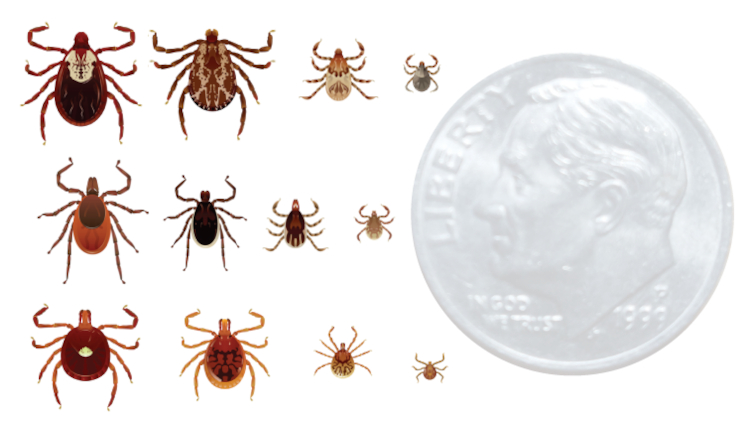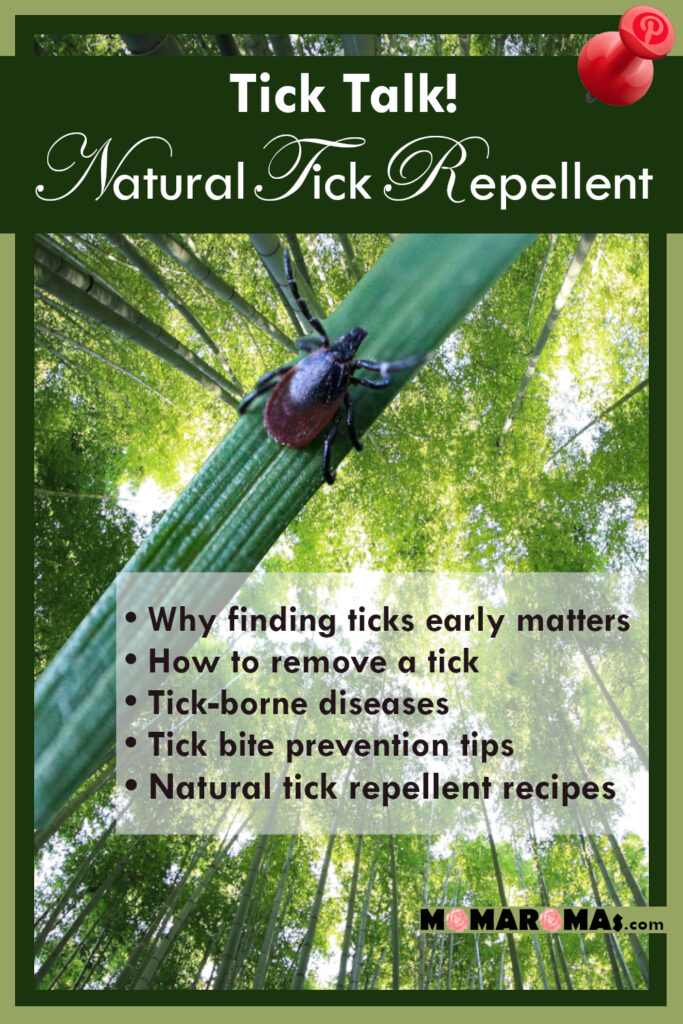
Tick Talk: Spotting Ticks, How to Remove a Tick, and Tick Repellent
Spending time outdoors offers numerous health benefits! During warm weather, we might spend time hiking through lush trails, camping, or simply enjoying the backyard or a picnic in a local park. As much fun as these activities are, they can also bring us into contact with tiny creatures that can pose serious health risks. We’re talking about TICKS!
Ticks are small, parasitic arachnids (spider family) that can transmit a range of diseases to humans and animals. If you find and remove a tick early—ideally before a tick bite occurs— the risk of disease transmission is greatly reduced. And using an effective tick repellent can help keep the buggers off in the first place!

Download Tick Talk Safety Guide!
- Tips to safely remove ticks
- Tick borne illness and symptoms to watch for
- 4 Natural Tick Repellent recipes
- including 2 kid-friendly recipes!
[This post contains affiliate links. If you make a purchase through one of these links I may earn a commission. This does not impact your price. For more information, please see our disclosure.]
In this Post
Spotting Ticks Early is a Big Deal
Think of ticks like tiny, stealthy hitchhikers. They can hop on without you even noticing! The longer they hang out and snack on you, the higher the chance they might share something you don’t want–like bacteria or viruses. That’s why being a tick detective and checking yourself regularly is your first line of defense. The sooner you find and remove a tick, the better!
After any outdoor adventure, give yourself a good once-over. Ticks are sneaky and love to hide in warm, protected spots:
- Scalp and Hairline: Run your fingers through your hair (they can be tiny) and feel for bumps on the skin.
- Behind Your Ears: A cozy little nook for a tick.
- Neck: Don’t forget the back!
- Underarms: Another favorite hiding spot.
- Waistband: They like the snugness of this area.
- Groin Area: Be thorough here!
- Behind Knees: They like to climb vertical surfaces and can latch on as you move.
- Between Toes: Easy to miss these little guys.
Also, remember to check your clothes, backpack, and camping gear—these are a common way for ticks to journey indoors.
If you’ve been outside with your pet, make sure to give them a thorough check, too, especially the base of the tail, neck, ear folds, and between the toes!
Comparing Tick Sizes

Image Credit: Cornell College of Agriculture and Life Sciences [1]
The Right Way to Remove a Tick
Okay, so you’ve spotted a tick that’s decided to hitch a ride. Don’t panic!
If it’s just crawling around, simply collect it in a tissue and dispose of it. Do not crush the tick. Just make sure it’s trapped really well in the tissue.
If the head is already embedded in your skin, take a deep breath and follow these easy steps to remove a tick.
- Collect the right tools. You’ll need a pair of fine-tipped tweezers, soap and water, a cotton ball or cotton round, and isopropyl alcohol.
- Get a grip. Put the tweezers right up against the skin and grab the tick where it’s embedded. Do not grab the body. This is very important!
- Pull straight out. Gently, but firmly, pull the tick straight up and away from your skin. This is very important, too, as a twist or jerk may leave mouthparts behind. If any mouthparts remain, attempt to remove them. If they do not come out easily, move to the next step.
- Save the hitchhiker. Pop the tick in a zipper-sealed bag or small container with a small damp paper towel. Note the date and probable location where the tick hitched a ride. Store in the refrigerator for several months. If you feel unwell later, this can help your doctor identify the type of tick.
- Clean everything. Once the tick is out, wash the bite area and your hands well with soap and water. Wipe the area with a cotton ball moistened with isopropyl alcohol. Also clean the tweezers with isopropyl alcohol and allow to air dry.

What NOT to Do to Remove a Tick
Forget old wives’ tales like smothering the tick with petroleum jelly, nail polish, or trying to burn it off. These methods can actually stress the tick and make it release more potentially harmful viruses or bacteria into your bloodstream. Use those tweezers!
Some Tick-Borne Diseases
Ticks can carry numerous disease-causing viruses, bacteria, and parasites. Here are some of the common diseases that can be transmitted through a tick bite.
| Disease | Source | Key Symptoms | Symptom Onset |
|---|---|---|---|
| Lyme Disease | Bacteria | Expanding “bulls-eye” rash, flu-like symptoms, joint pain | 3–30 days |
| Anaplasmosis | Bacteria | Fever, chills, headache, muscle pain, GI symptoms | 1–2 weeks |
| Babesiosis | Parasite | Flu-like symptoms, fever, chills, fatigue, body ache; may lead to hemolytic anemia | 1 week-several months |
| Ehrlichiosis | Bacteria | Fever, chills, headache, muscle pain, GI symptoms, confusion, rash (common in children) | 1–2 weeks |
| Powassan | Virus | Fever, headache, GI symptoms; may lead to encephalitis | 1-5 weeks |
| Rocky Mountain Spotted Fever | Bacteria | Rash, fever, severe headache, muscle pain | 2–4 days |
| Tularemia | Bacteria | High fever, ulcers, swollen lymph nodes | 3–5 days |
Source: U.S. Centers for Disease Control & Prevention[2]
When to See a Doctor After a Tick Bite
If you notice any of these symptoms after a tick bite, check in with your doctor. Tell them about the tick bite and any symptoms you’re experiencing. Early diagnosis and treatment can make a big difference. If you saved the tick, bring it with you to the appointment—it may help with diagnosis.
Where in the World Are Ticks Found?
Ticks are found all over the world, with significant populations on every continent except for the Arctic, the Antarctic interior, and some of the driest deserts.[3] Ticks thrive in warm, humid environments with plenty of vegetation, such as forests, grasslands, and areas where wildlife like deer, rodents, and birds are common.
Ticks are highly adaptable and can even be found in urban environments, especially where there are parks or gardens with suitable hosts. Their global distribution is expanding due to factors like climate change and increased movement of animals and people.
Avoid a Tick Bite with Natural Tick Repellent
Alright, we know how to remove a tick from our skin, and what symptoms to look for after a tick bite. Now let’s craft these natural and effective tick repellents. They’re made with proven essential oils, such as Clove Bud, which is one of the most effective essential oils for repelling ticks.[4][5][6]
But first, some other simple steps you can take before applying a tick repellent:
- Wear a hat with a brim.
- Wear a light colored, long sleeve shirt with fitted wrists.
- Wear light-weight long pants and tuck them into socks.
⭐️Tick Repellent Spray for Clothes
Let’s make this tick repellent for clothing in a 2-ounce spray bottle. This is the perfect size for slipping into a bag or backpack.
- 2-ounce spray bottle
- 2 teaspoons (10ml) 70% Isopropyl Alcohol (or Everclear)
- 1/8 teaspoon (0.6ml) Glycerin
- 10 drops Cedarwood Virginian (Juniperus virginiana)
- 10 drops Thyme benchmark (Thymus zygis)
- 8 drops Geranium (Pelargonium asperum)
- 6 drops Clove Bud (Eugenia caryophyllata/Syzygium aromaticum)
- 4 drops Amyris (Amyris balsamifera)
- Distilled water or hydrosol of choice (Catnip*, Rose Geranium, and Peppermint are good options)
🌺See my Recommended Suppliers below
*Catnip note: If you are hiking or camping where big cats can be found, please do not use Catnip hydrosol in your tick repellent spray. Big cats are attracted to catnip, too![7]
To Make: Add alcohol and glycerin to spray bottle, then add essential oils. Cap the bottle and shake to combine. Allow to sit for at least 30 minutes. Fill to the shoulder with distilled water or hydrosol. Cap and shake to combine.
To Use: Shake well. Apply outside. Mist shoes, pant legs, shirt, jacket, and hat with tick repellent spray prior to outdoor activity. Reapply occasionally.
⭐️Kid-Friendly Tick Repellent Spray for Clothes
Make and use the kid-friendly spray just like the “regular” version. This tick repellent spray is safe to use on the clothes of children over 3 years of age. Reapply occasionally, especially on shoes and pant legs.
- 2-ounce spray bottle
- 2 teaspoons (10ml) 70% Isopropyl Alcohol (or Everclear)
- 1/8 teaspoon (0.6ml) Glycerin
- 7 drops Cedarwood Virginian (Juniperus virginiana)
- 3 drops Thyme benchmark (Thymus zygis)
- 3 drops Geranium (Pelargonium asperum)
- 2 drops Amyris (Amyris balsamifera)
- Distilled water or hydrosol of choice (I like Rose Geranium for kids)
Why the Alcohol? We’re using the alcohol in these blends to solubilize the essential oils and extend the shelf-life. If you wish to eliminate the alcohol, replace with distilled water or hydrosol. Shake very well just before use and repeatedly during application. Discard alcohol-free blends after 1 week.
⭐️Tick Repellent for Skin
I prefer to use an oil base for this topical tick repellent blend as it stays on the surface of the skin longer than a lotion. However, a lotion can be used if that is your preference. You can also make this into a balm with beeswax and butters, if desired—store in a 2-ounce jar.
- 2-ounce pump bottle
- Jojoba oil/wax (Simmondsia chinensis) or fragrance-free Lotion
- 6 drops Cedarwood Virginian (Juniperus virginiana)
- 6 drops Thyme benchmark (Thymus zygis)
- 6 drops Geranium (Pelargonium asperum)
- 4 drops Amyris (Amyris balsamifera)
- 3 drops Clove Bud (Eugenia caryophyllata/Syzygium aromaticum)
🌺See my Recommended Suppliers below
To Make: Fill pump bottle halfway with Jojoba, then add essential oils. Cap and shake to combine. Fill to the shoulder with Jojoba. Cap and shake well to combine.
Kid Safe Option: Eliminate the Clove Bud, halve the number of drops of the remaining essential oils, and keep the same amount of Jojoba. This blend is safe for use on children over 3 years of age.
To Use: Prior to outdoor activity, apply lightly to exposed areas, such as ankles, wrists, and back of neck. Not for use on the face. Reapply occasionally. Use in combination with a tick repellent clothing spray.
In just a few minutes you can make several tick repellent products and can feel great about spending the entire day exploring and having fun all Summer long! Still remember to do a thorough tick check when you get home, though!

📌Pin the Post
References
- Cornell College of Agriculture and Life Sciences. (nd). Tick Biology. https://cals.cornell.edu/integrated-pest-management/outreach-education/whats-bugging-you/ticks/tick-biology
- U.S. Centers for Disease Control & Prevention. (2024). About Ticks and Tickborne Disease. https://www.cdc.gov/ticks/about/index.html
- Insect Shield. (nd). Where Do Ticks Live? Understanding Tick Habitats. https://www.insectshield.com/blogs/blog/where-do-ticks-live
- Le Mauff, A., Norris, E.J., Li, A.Y., Swale, D.R. (2024). Repellent activity of essential oils to the Lone Star tick, Amblyomma americanum. Parasites & Vectors, 17:202. https://doi.org/10.1186/s13071-024-06246-0
- Carroll, J.F., Paluch, G., Coats, J., Kramer, M. (2010). Elemol and amyris oil repel the ticks Ixodes scapularis and Amblyomma americanum (Acari: Ixodidae) in laboratory bioassays. Exp Appl Acarol, 51(4):383-92. https://doi.org/10.1007/s10493-009-9329-0
- Gonzalez, J., Lockhart, A., Wu, Q., Simon, J.E., Toledo, A. (2022). Repellency of novel catnip (Nepeta cataria) cultivar extracts against Ixodes scapularis and Haemaphysalis longicornis (Acari: Ixodida: Ixodidae). Ticks and Tick-borne diseases, 13(6):102046. https://doi.org/10.1016/j.ttbdis.2022.102046
- Big Cat Rescue. (nd). Cats in a Spin Over Catnip. https://bigcatrescue.org/conservation-news/cats-in-a-spin-over-catnip

- 7 Tips for Staying Cool in Summer Heat
- Make an Easy After Sun Cooling Spray
- Summer Cooler Essential Oil Blend
- Summer Radiance Essential Oil Blend
- Summer Memories Essential Oil Blend
- Fireworks Fear Essential Oil Blend (for dogs & humans)
- Summer Dreams Herbal Tea Recipe
- Cooling Herbal Cold Brew Tea
- Overworked Muscles Inhaler Blend & Massage Oil
- Tips for Ticks + 4 Tick Repellent Recipes

Mom’s Tick Repellent Shopping List
- Containers:
- Amyris essential oil (Amyris balsamifera):
- Cedarwood Virginian essential oil (Juniperus virginiana):
- Aromatics International, wildcrafted
- Plant Therapy, sustainable (Direct and Amazon).
- Clove Bud essential oil (Eugenia caryophyllata/Syzygium aromaticum):
- Aromatics International, sustainably wildcrafted
- Plant Therapy, organic (Direct and Amazon).
- Geranium essential oil (Pelargonium asperum):
- Aromatics International, organic Rose Geranium
- Plant Therapy, organic Egyptian Geranium (Direct and Amazon)
- Plant Therapy, sustainable Bourbon Geranium (Direct and Amazon).
- Thyme Benchmark essential oil (Thymus zygis):
- Aromatics International, organic.
- Hydrosols:
- Catnip hydrosol (Nepeta cateria) from Aromatics International, organic (also on Amazon)
- Peppermint hydrosol (Mentha x piperita) from Aromatics International, organic (also on Amazon)
- Rose Geranium hydrosol (Pelargonium spp) from Aromatics International, organic (also on Amazon).
- Jojoba oil/wax (Simmondsia chinensis):
This information has not been evaluated by the Food and Drug Administration and is not intended to diagnose, treat, cure, or prevent any disease. It is for educational purposes only.
All recipes provided are for personal use and are not designed for re-sale or large-scale manufacturing.
Please consult your doctor, naturopath, herbal practitioner, or other qualified health professional for medical advice and before starting any herbal regimen, particularly if you are pregnant or nursing, have any existing medical conditions, or are taking any medications.

Chris P | Author, Certified Aromatherapist, Natural Skin Care Formulator
Chris (“Mom”) enjoys formulating bespoke aromatherapy, skin care, and herbal products to support her family, pets, friends, and clients. She also loves experimenting with recipes in the kitchen. An avid reader, writer, and lifetime learner, Chris enthusiastically explores research rabbit holes and then writes about her discoveries.💚 (Learn more >>)





